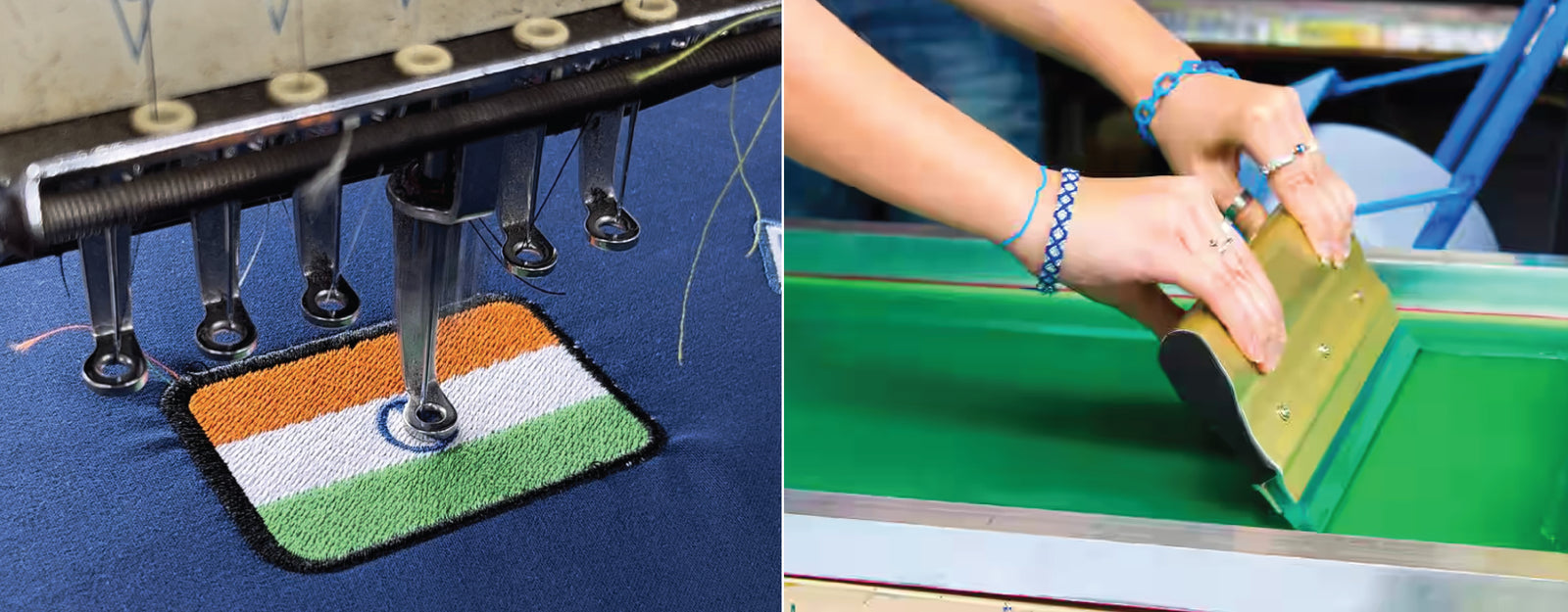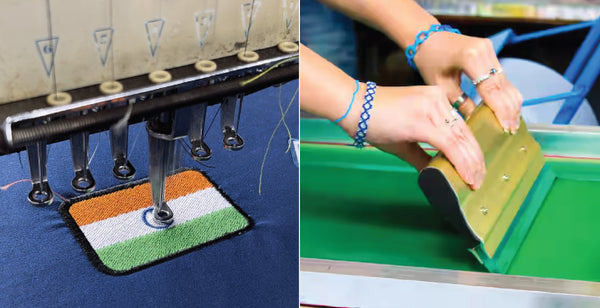Embroidery is a timeless craft of stitching threads, achieving a raised, textured look, perfect for logos and small details on sturdy fabrics. rivals printing in adorning fabrics. Screen printing, fast and vibrant, excels for large designs on t-shirts, while embroidery's 3D texture shines on polos and caps. Sublimation, fusing dyes onto polyester, creates photorealistic prints but can fade. Cross stitch, a meditative art form with counted threads, differs in its gridded patterns. DTG printing, like a digital inkjet, offers endless color possibilities on cotton but lacks embroidery's durability. Each technique boasts unique strengths, so choosing the perfect one depends on your design, fabric, and desired aesthetic.
- Embroidery: Timeless touch, raised and textured, great for logos and details; prefers robust materials. Think of exquisite polo logos or elaborate cap insignia.
- Printing: Versatile & fast for large designs on t-shirts and delivers bold graphics on casual tees.
- Screen Printing: Quick and bright, excels at huge graphics, ideal for t-shirts. Consider how bold designs might look on your casual shirt.
- Sublimation: Sublimation creates photorealistic effects on polyester, but careful of fading. Picture: beautiful scenery sublimated onto sports shirts.
- Cross Stitch: Meditative art with a gridded appeal, ideal for pixelated designs. Think of lovely scenery embroidered with numbered thread.
- DTG Printing: Unlimited colour options on cotton, however durability falls short. Imagine having photorealistic graphics printed straight on tote bags.
Shop Best Lab Coats from Here!
Embroidery vs Printing
Choosing between Embroidery vs Printing hinges on the perfect blend of aesthetics and practicality. Embroidery, with its raised, stitched detail, shows sophistication and durability. It's a timeless choice for logos on heavier garments like shirts and caps, but its intricate nature can limit complex designs and feel bulky on thin fabrics. Printing, on the other hand, offers vibrant color gradients and photographic detail, making it ideal for large, eye-catching graphics on t-shirts and hoodies. However, its ink-on-fabric nature compromises longevity, prone to fading and cracking with wear. Ultimately, the battle of Embroidery vs Printing boils down to your priorities: prioritize timeless elegance and endurance? Choose embroidery. Crave bold, photorealistic designs on lightweight fabrics? Printing might be your champion. Consider your needs, weigh the pros and cons of each technique, and make the choice that brings your vision to life!
Embroidery Vs Screen Printing
A Tale of Two Textures: Embroidery vs Screen Printing. Embroidery stitches into the cloth, resulting in raised, dimensional designs ideal for logos and tiny details. Think luxury, elegant, and understated. Screen Printing is perfect for bright, full-coverage designs. For bigger designs, choose bright, eye-catching, and cost-effective options. So, which one will grace your next masterpiece? Choose Embroidery for a classy look, or Screen Print for a flash of individuality. It's all about finding the appropriate balance of fabric, design, and your individual flair. Remember, embroidery vs screen printing: two options, limitless possibilities.
Explore All Women's Scrub
Embroidery vs Sublimation
Choosing between embroidery vs sublimation comes down to the battle of texture vs brilliance. Embroidery is the process of stitching a raised design on cloth using thread, giving it a traditional, 3D appearance and amazing durability. Consider varsity jackets with monograms with classic elegance. However, intricate designs can be expensive and time-consuming to stitch.
In scrutiny, Sublimationemploys heat to infuse colours into synthetic textiles, resulting in lifelike, full-color prints with seamless transitions. It is ideal for elaborate drawings and brilliant gradients, but lacks tactile appeal and may fade over time. Finally, embroidery vs sublimation is a toss-up between boosted elegance and photorealistic flare, with the winning process influenced by your desired style, budget, and fabric pick.
Embroidery Vs Cross Stitch
While both embroidery Vs cross stitch involve adorning fabric with a needle and thread, their approaches differ like brushstrokes and pixels. Embroidery is a vast canvas of free-flowing creativity, with endless threads, textures, and mixes swirling over cloth. Imagine landscapes with a mirror-like sheen, flowers bursting with French knots, and delicate designs highlighted in stem stitch.
On the other hand, Cross Stitch thrives on structure. every domain is the pixelated grid, where each X-shaped stitch cautiously fills every square, resulting in vivid visuals with mosaic-like appeal. Think pixelated art of portraiture, fun samplers, and colourful geometric patterns. So, embroidery vs cross stitch is a harmonic spectrum, with one luxuriating in artistic freedom and the other enjoying defined accuracy. Choose your needle, thread your palette, and discover where your stitching journey takes you!
Browse Best Scrubs Collection
Embroidery vs DTG printing
Embroidery vs DTG printing: two popular methods for adorning garments, each with its own strengths and quirks. Embroidery involves by hand sewing thread into cloth, resulting in a raised, textured design that is extremely durable and may persist for years. Think of it as miniaturised stitching. DTG printing, on the other hand, digitally sprays ink straight into the garment, creating a smooth, almost painted-on finish. It is speedier and more adaptable for intricate drawings, but it might fracture or fade over time, especially on heavily washed stuff. The choice between embroidery vs DTG printing relies on your priorities. Embroidery has a more quality, traditional appearance that stands out, making it excellent for logos, lettering, or simple designs on caps, polos, or bags. DTG printing produces colourful pictures, gradients, and complex details, making it ideal for t-shirts, hoodies, and any item that requires a full-color image. Ultimately, the greatest option for you is determined by your desired design, budget, and intended usage for the garment.
So, embroidery vs DTG printing? The answer is in your vision!
From the timeless elegance of embroidery (think raised logos on polos) to the affordable pop of screen printing (vibrant designs on shirts!), the realm of decorating is a tapestry woven with possibilities. Sublimation infuses photographs straight into fabric, creating athletic enchantment, whilst cross stitch adds pixelated beauty to little masterpieces. DTG printing's digital paintbrush dances over t-shirts, but keep in mind that detailed graphics may fade with severe washing. So drop the "vs," embrace the "&," and let your vision grow, thread by thread, ink by wonderful ink!
| Check out More Articles | |
| Difference Between Cartilage and Bone | |
| Difference Between Endocrine and Exocrine Glands | |
| Difference Between Cell Wall and Cell Membrane | |















